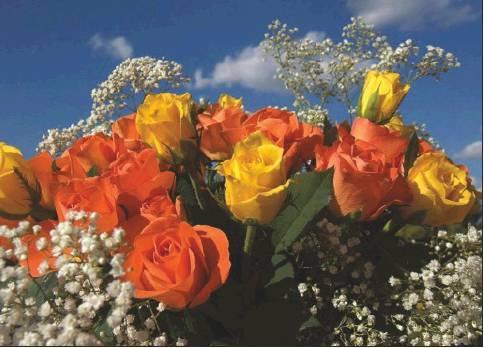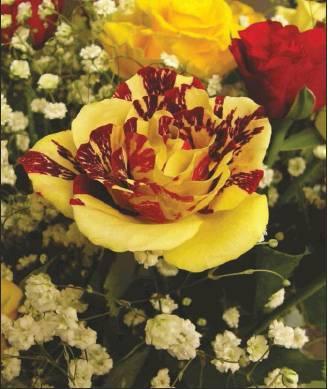The Rose, June’s Birth Flower
Getting into Gardening
Roses say “I love you” like no other flower and in June they also say “Happy Birthday” since they are the main birth flower for the month. The secondary birth follower for the month is honeysuckle, but there is so much to say about the rose that I’ll leave honeysuckle for another article.
Roses have been around for centuries and have been written about and referred to for all that time. That just shows the appeal they have had since very first was cut and given as a gift of love.
“The optimist sees the rose and not its thorns; the pessimist stares at the thorns, oblivious to the rose,” ~ Kahlil Gibran.
Roses have a long and colorful history. They have been symbols of love, beauty, war, and politics. The rose is, according to fossil evidence, 35 million years old. In nature, the genus Rosa has some 150 species spread throughout the Northern Hemisphere. Garden cultivation of roses began some 5,000 years ago, probably in China. During the Roman period, roses were grown extensively in the Middle East. They were used as confetti at celebrations, for medicinal purposes, and as a source of perfume. Roman nobility established large public rose gardens in the south of Rome.
During the fifteenth century, the rose was used as a symbol for the factions fighting to control England. The white rose symbolized York, and the red rose symbolized Lancaster, as a result, the conflict became known as the “War of the Roses.”
Roses were in such high demand during the seventeenth century that royalty considered roses or rose water as legal tender, and they were often used as barter and for payments. Napoleon’s wife Josephine established an extensive collection of roses at Chateau de Malmaison, an estate seven miles west of Paris in the 1800s. This garden became the setting for Pierre Joseph Redoute’s work as a botanical illustrator. In 1824, he completed his watercolor collection “Les Rose,” which is still considered one of the finest records of botanical illustration.
It wasn’t until the late eighteenth century that cultivated roses were introduced into Europe from China. Most modern-day roses can be traced back to this ancestry. These introductions were repeat bloomers, making them unusual and of great interest to hybridizers, setting the stage for breeding work with native roses to select for hardiness and a long bloom season. Many of these early efforts by plant breeders are of great interest to today’s gardeners.
Roses are once again enjoying a resurgence in popularity, specifically, shrub roses and old garden roses. There are also climbing varieties of roses that will crawl up a trellis or wall. Gardeners realize that these roses fit the lifestyle of today’s gardeners who want roses that beautiful, disease resistant, offer outstanding floral quality, have excellent winter hardiness, and fit into shrub borders and perennial gardens without seeming out of place.
Roses are red, and pink, and many other colors. Giving roses as a gift shows a deep appreciation for the recipient and your feelings towards them. Roses are the most popular flowers in the world and although all roses symbolize love and appreciation, the color of the flower petals have come to have very specific meanings. Let’s look at a few.
Red – Red roses are the traditional symbol for love, romance, and will always be a way to say “I love you.” The red rose has also reflected beauty and perfection. Deep or dark red roses can reveal an unconscious beauty.
Pink- Words like admiration, gentleness, grace, gladness, joy and sweetness are just a few ways to describe the meaning behind the pink rose. A pink rose can also convey happiness, gracefulness and admiration.
Yellow- Bright, cheerful and joyful are what come to mind when thinking of a yellow rose. Yellow roses create warm feelings and provide happiness. Giving yellow roses can tell someone the joy they bring you and the friendship you share.
White- White roses, the purist of colors, represent innocence, purity and charm. White roses are traditionally used in weddings and can represent new beginnings. We believe that white roses can also express remembrance and innocence.
Orange/Salmon- Orange roses evoke energy, and can indicate enthusiasm, desire and excitement. Giving orange roses can symbolize your passionate romance and share your excitement of the relationship with your loved one.
Lavender- Probably the most mystical and fairy-tale perfect color of rose is lavender. It is said if someone gives you a lavender rose it means they fell in love with you at first sight, just like Cinderella’s Prince Charming. It’s interesting as well to note that purple is a royal color, so sending a single purple rose means you find her majestic, opulent and special. If you are seeking to voice your deepest love and admiration for someone consider sending them a lavender bouquet.
Love at first sight or just an enchanting way to say, “I love you!” Lavender roses can offer a daily reminder of your love and eagerness to grow your relationship.
Peach- Are you grateful for someone or just want to show your appreciation? Then consider giving a peach-colored rose. A bouquet of peach roses shows your deep appreciation and gratitude or just an elegant way to say, “Thank You!”
Cream- Cream roses are indicative of charm and thoughtfulness. They go well with pink “thank you” roses which allow you to send two messages in one bunch!
Green- Green is the color of life, abundant growth, and constant renewal of life and energy. The green rose signifies the constant rejuvenation of spirit and is therefore a messenger of cheerfulness.
Burgundy- Burgundy roses have a very specific connotation of unconscious beauty. In the Victorian era, deeper rose colors signified deeper passion. Per this schema, burgundy roses signify a very deep passion, even beyond that of red roses.
Blue- True blue roses are not found in nature. Natural roses that are considered “blue” are actually a blue-toned purple. However, blue roses can also be obtained by dying white roses. Because they can’t be obtained naturally, blue roses symbolize the unattainable and the mysterious.
Black- Black roses are another color that is not found in nature. Natural roses that are called “black” are actually a very dark red or purple color. True black roses can only be obtained through dyeing. Black roses symbolize death, rebirth, and goodbye.
Sometimes the numbers say everything...
• A single rose of any color depicts the utmost devotion or a way to say “thank you”
• Two roses entwined together communicate “marry me” (a red and white rose entwined means unity)
• Six Roses signify a need to be loved or cherished
• Eleven roses assure the recipient they are truly and deeply loved
• Thirteen roses indicate a secret admire
Tennyson famously said, “If I had a flower for every time I thought of you . . . I could walk through my garden forever,” It is so true. Preparing these birth flower articles has been loads of fun for me, my love and appreciation for all that Nature offers, like the flowers in my garden, just continues to grow!




